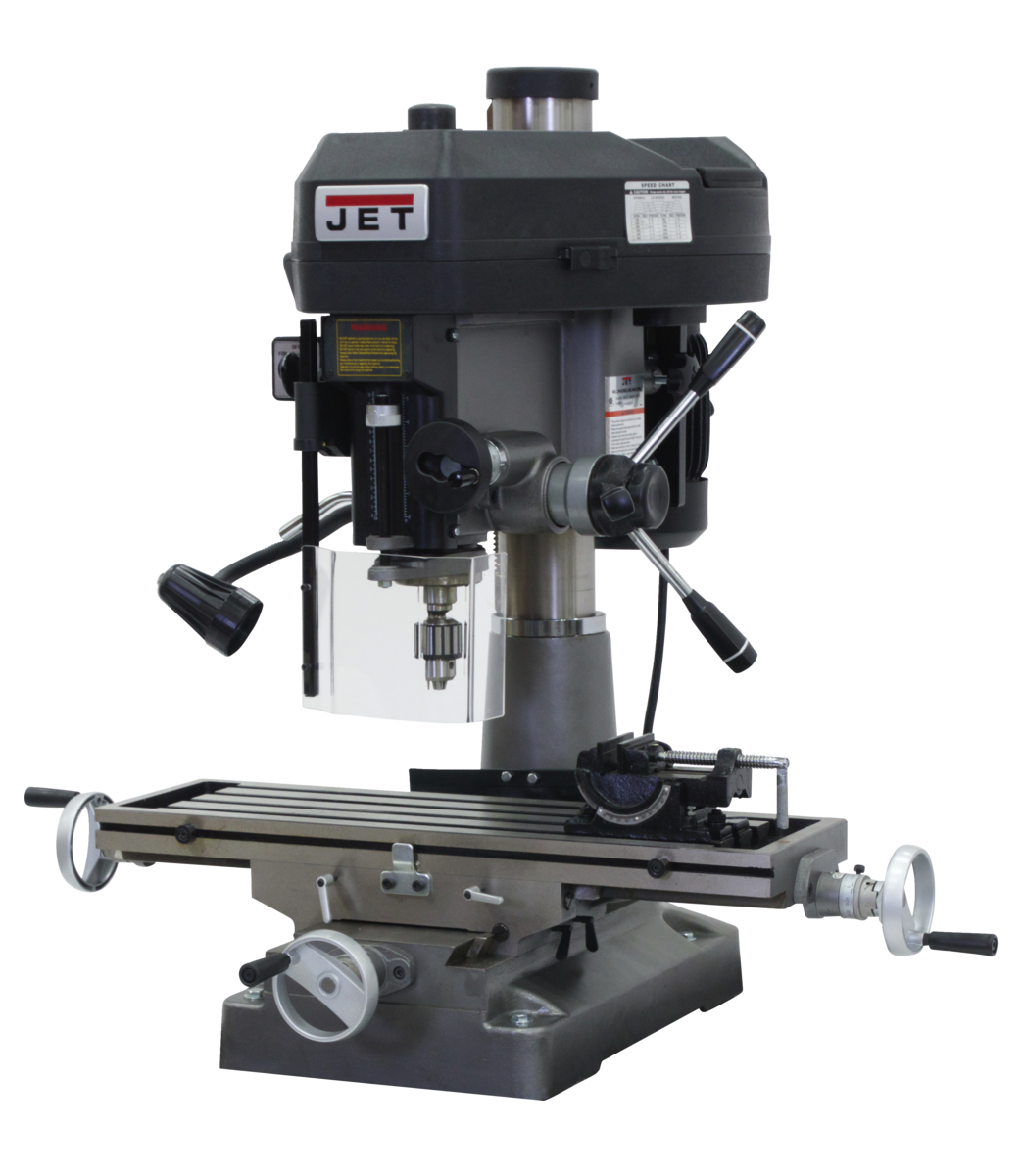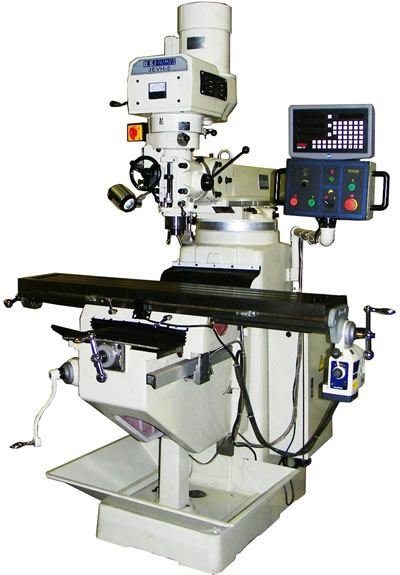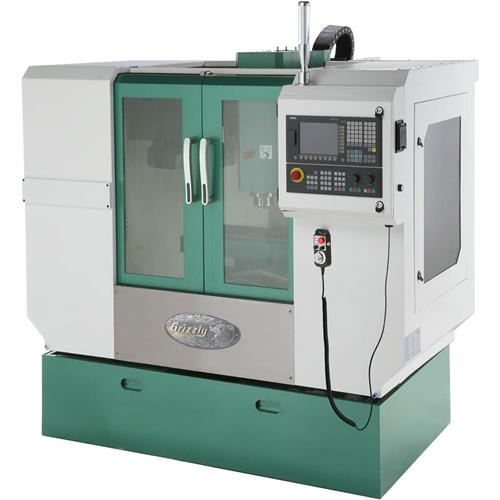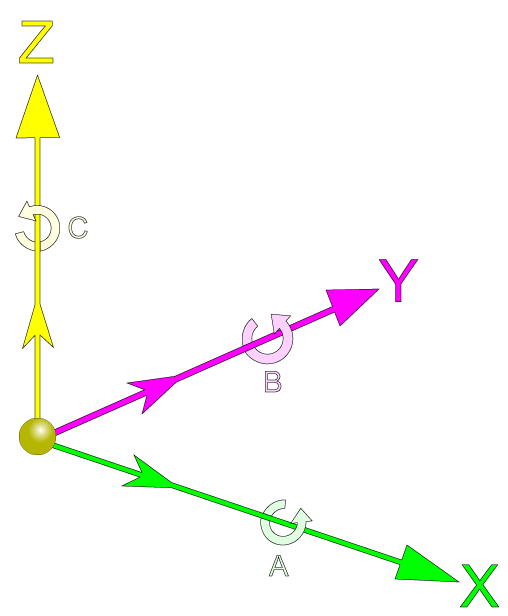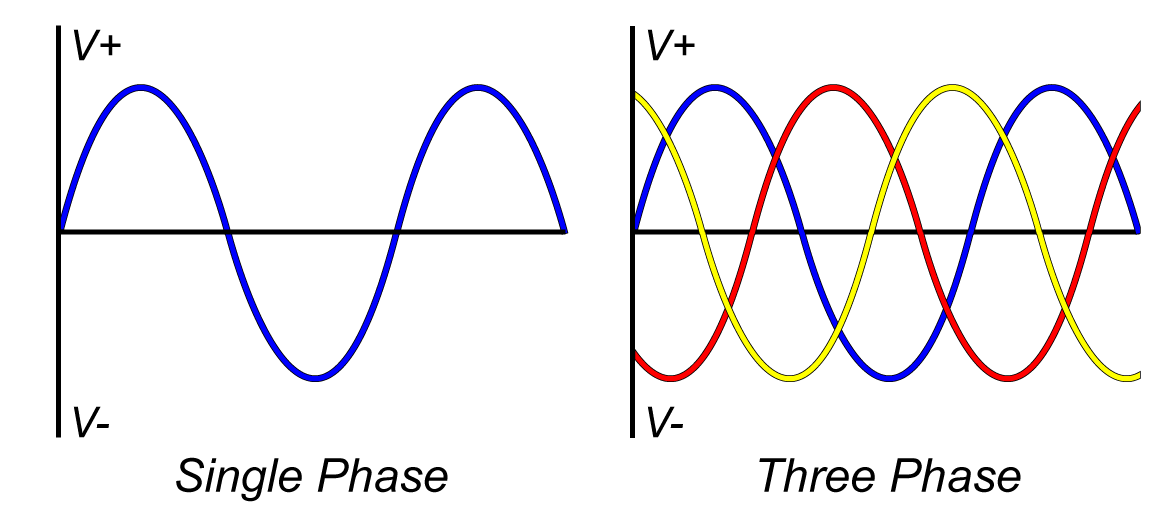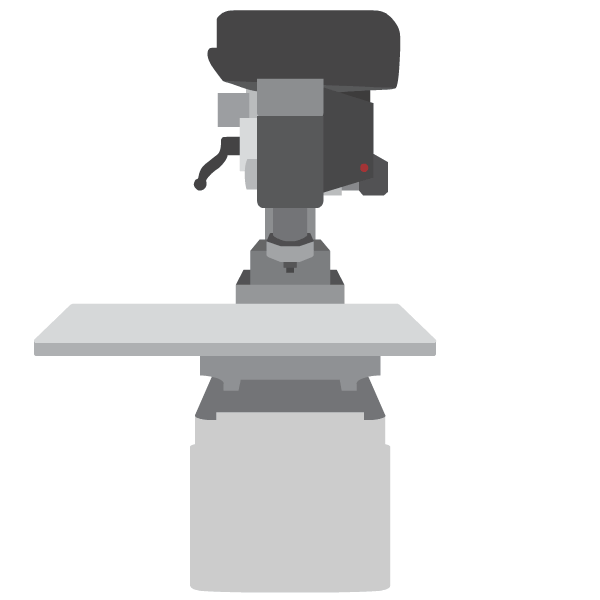Elite Metal Tools Articles
Industry news, tips, and updates on all things Elite Metal Tools
How To Choose the Right Milling Machine
Milling Machines are often the catch-all of a metalworking shop. With more applications than we could name, milling machines are a highly versatile addition to any shop. But there are many things to consider before buying a new milling machine—your application, operating volume, capacity needs, etc.
First, what is the basic functionality of a milling machine? Milling machines are used to cut into material and remove layers with great accuracy. This process, also known as machining, is done on lathes, milling machines, drill presses, grinders, etc. Machining is an incredibly precise art and the tools needed to be successful are equally precise in nature. What makes a milling machine unique, and incredibly valuable in a shop is its speed, precision, and versatility. Its speed is generally attributed to the popularity of CNC controls, but even experienced mill operators can make quick work of a precise project using traditional controls. By having complete control over the X, Y, and Z axis of the cutting tool, an operator is only limited by their imagination. The versatility of milling machines is by far the most notable. There are thousands of options in cutting tools, each offering different functions. These cutting tool bits can be used to engrave, carve, cut, or even finish metal.
Milling Machines vary greatly in price—mostly based on factors such as swing & table size, spindle to table max, capacity, speed options, and control type. Let’s discuss these factors and what options may be best for you!
Milling Machine Type
There are several different types of milling machines, some with their own subcategories. Vertical milling machines are by-far the most common and most used type of milling machine. Similar to a drill press, it has a vertically aligned spindle, but the table moves on the X and Y axis allowing it to mill. Horizontal milling machines are similar with a X and Y moving table; however, the cutter is on a horizontal orientation. Other milling machine variants, such as universal milling machines, gantry milling machines, CNC and machining centers, etc. are classified by their operation type, size, and construction. Since vertical milling machines are by-and-large the most utilized style of milling machine, our focus will primarily be on their orientations and different specifications.
Bench vs Knee Mills
The first distinction to make when searching for a new milling machine is that of bench mill vs knee mill. Some would argue that the only differences are their price and quality. However, both mill types have their own strengths, and each are suited for different applications. Bench mills—often referred to as mill drills—are exactly what you expect. They are bench-mounted milling machines that can be bolted to any work surface. Bench mills are very similar to standard bench drill presses, however, have features that allow it to mill (cut along the X and Y axis without changing the Z depth). When working with a bench mill, the table does not move vertically, rather, the headstock lowers to the desired depth. Mill drills, however, have a stationary headstock with a vertically moving table. Mill drills generally have a much stronger construction and are by-and-large considered a more accurate milling machine. Both bench and knee mills have a drill press action, where the quill can be lowered using a handwheel or lever.
Axes Number & Orientation
Milling operations are generally straight forward—they drill, end mill, square, shoulder mill, slot mill, etc. In our typical 3-axis orientation, the table moves the workpiece on an X and Y axis, the head or table moves on the Z axis, and the cutting tool does the rest. The most popular milling machines operate on 3 axes and this orientation is what you can expect for the majority of milling machines on the market. As always, application is key in determining the axis orientation you’ll need for your shop. In short, as the complexity of your desired finished product increases, as does the need for more axes of movement. Nearly all 4-axis and 5-axis milling machines are CNC operated.
In 4-Axis milling machines, the 4th axis of movement is always a rotation of one of the 3 primary axes—X, Y, or Z. 5-Axis milling machines are similar, but have multiple rotating axes. It is generally understood that the linear axis of movement (X, Y, Z) corresponds with the rotational axis (A, B, C) as such: The A axis is the rotational axis of X, the B axis is the rotational axis of Y, and the C axis is the rotational axis of Z.
Though this is a general breakdown of multi-axis operation, it should give you enough information to make an informed decision regarding what type of milling machine will work best for your shop or business. If you have more questions, Elite Metal Tools sales staff can assist you in finding the right machine for your application.
Traditional, CNC, and Power Feed
Conventional milling machines operate on the 3 axes by the operator’s use of handwheels. The handwheels are marked incrementally by millimeter or other measurements to give the operator full control over the movement of the table. Conventionally operated machines are always knee mills, meaning one of the three handwheels move the table vertically on the z-axis—thus determining the depth of a milling operation. Also, conventional mills often have optional Digital Readout (DRO) systems. DROs provide a real-time, incredibly accurate readout of the axis locations. Though experienced operators may not need a DRO, these tools can greatly increase accuracy and curb human error. Traditional milling machines can perform any operation that is expected from a vertical milling machine. However, it is limited by the skill of the operator and the time needed to execute cuts.
By far, the most common variant of milling machine is those with power fed axes. Classified as conventional milling machines, power feed milling machines move on either the X, Y, or Z axis using a power feed motor. With a simple lever pull or button press, the table will move along, generally, the X or Y axis at a consistent speed. Power feeds can reduce the chances of human error when milling, increase operation speed, and decrease operator fatigue in high production shops. Milling machines can be purchased with a power feed on any of the 3 axes, additionally, traditional milling machines can be retrofitted with a power feed on the X or Y axis.
NC, or Numeric Control milling machines are quickly becoming obsolete. Due to technology costs decreasing, and technology becoming more accessible, CNC machines are taking their place in the market. However, some NC milling machines are still sold and operated in the US. Their similarity to CNC machines is the ability to replicate operations, with precision, many times in a row. And, with little operator interference. Unlike the newer, more advanced CNC mills, NC milling machines are unable to save, edit, or create sets of operations. Rather, they are only able to read a set of instructions, and mill.
CNC machines are undoubtably the most accurate, efficient, and easy-to-operate vertical milling option. Operators create digital images of the desired end product, either on an external computer or on the CNC machine’s built-in computer. These 3D files are read by the operating computer, and automatically generates a set of instructions. Quickly becoming the most popular option—especially for high volume shops— CNC milling machines reduce the risk of user error to nearly zero. Vertical CNC operated milling machines come in one of two styles, a more standard-looking knee mill style, or a fully enclosed style—AKA Machining Centers. CNC machining centers are also able to utilize coolant more effectively. The fully enclosed machine keeps liquid coolant and metal shaving inside, while also protecting operators and personnel.
Other Specifications
A milling machine’s specifications are the nitty gritty details worth considering when looking for a milling machine that matches your needs.
Spindle to Table Max
This first detail may be self-explanatory, but it is an important factor to consider. In vertical milling machines, your spindle to table maximum refers to the maximum vertical distance between your table—where your workpiece is fastened—and your spindle. This, like all other specifications below, is determined by your specific application. When working with oversized workpieces, understanding your vertical clearance and capacity will make or break your milling operation. It is also worth noting that your spindle to table maximum does not include your tooling. Larger tooling can impact the amount of clearance on your machine.
Spindle Speed
Spindle speed is a crucial aspect of your milling machine to consider. Selecting the appropriate spindle speed range effects the tooling size, feed rate, and cut depths you’re able to utilize. According to recent trends, more shops are opting for higher rpm (rotations per minute) machines with small, coated tooling, cutting at shallower depths. These fast feed rates and spindle speeds result in cleaner finishes and require less horsepower and torque—and in turn, changes the Power requirements. When making large cuts with large diameter tooling lower spindle speed is required, as well as higher horsepower and torque. Understanding what you want out of your milling machines—in regard to finish quality, operations speed, operational capacity, etc., will help you decide the best orientation for you.
Lubrication & Coolant
It is safe to say that most new milling machine models have an integrated cooling and lubrication system. However, it is still common to see traditional milling machines without these systems. The industry agrees that cutting oil aids in the performance and longevity of your milling machine—and is essential for the mere operation of CNC operated machines. Dry milling is a common practice and has its place in different applications. It also decreases cost and creates a cleaner work environment. However, since milling machines are utilized for so many different applications, it is still a wise decision to consider a lubrication system for your new milling machine.
What is cutting oil? Cutting oil or cutting fluid is a specifically engineered fluid that serves three purposes when used in milling. It first lubricates the cutting tool. This decreases the stress on the cutting tool and workpiece, allowing for smoother cuts and longer lasting tools. Its second function is to act as a coolant. Cutting oil/fluid pulls away heat from the surface of the workpiece as well as from the cutting tool, extending the life of your tool, as well as preventing warping and seizing. Lastly, cutting fluid clears the surface of the workpiece of all chips and shavings. This makes operation easier when not CNC controlled and reduces the risk of unwanted chipping and errors.
Power
When selecting the type on input power, you have two options— Single Phase (1Ph) or Three Phase (3Ph). The difference between the two I surprisingly simple. Single phase is a two-wire system where one carries power, and the other is neutral—with power current running through the load wire and neutral wire. Single phase power is low voltage and creates a single sine wave, indicating inconsistent power flow. Three Phase power uses up to 4 wires and provides 3 alternating currents. Three Phase power is higher voltage and creates 3 alternating sine waves. This provides a more stable and consistent power supply.
When choosing between the two options the major determining factor is, as usual, application. Three phase machines are generally more capable of supporting larger loads than single phase machines. Three phase machines take a higher electronic load and therefore can handle higher capacity operation. For applications that do not require high-torque, high load operation, single phase machines may be a better option. Single phase machines are incredibly useful for shops that periodically utilize the milling machine. They are also already set up to be used in any shop. Three phase machines require special wiring that many shops do not have set up. If you are interested in utilizing the benefits of three phase, we recommend that you work with a certified electrician to set up your power requirements.
Table Size & Table Travel
An equally important factor to consider when choosing a milling system is its capacity abilities. Choosing a machine with equal or greater range than required is essential to precision milling. Adjusting the workpiece in order to mill beyond your machine’s capacity is very common, but will never produce accurate, replicable products. This method also takes more time—slowing the production of your shop.
The table size of a milling machine is self-explanatory. These table dimensions are important to consider depending on your applications for the machine. However, the table dimensions are only relevant depending on the table travel (or swing) of the system.
Known as the table travel, swing, or axis travel, this measurement determines how large the milling-capable table surface is. While a table may be 6” x 24”, the table travel could only be 6” x 12”. This is a major factor to consider, as you cannot mill over the entire table’s surface.
If you are milling small parts, we recommend purchasing a milling machine with a table swing slightly larger than required. This will give you a little more freedom and versatility without spending more than necessary. When milling parts larger than the table size and table swing, we recommend utilizing CNC software to accurately align your workpiece between milling cycles. This reduces operator error and helps maintain consistency.
Regardless of your application, there is always a milling machine that will fit your needs. From benchtop Mill Drills to 5-axis Milling Centers, we can help you find what works for your shop or business. Can't find what you need in-stock? Give us a call. Our team will go to work for you finding what you need inside your budget. If you're not sure what your shop or business needs, talk to one of our industry specialists. As always, we hope you choose Elite Metal Tools , so you can experience the Elite Advantage.
